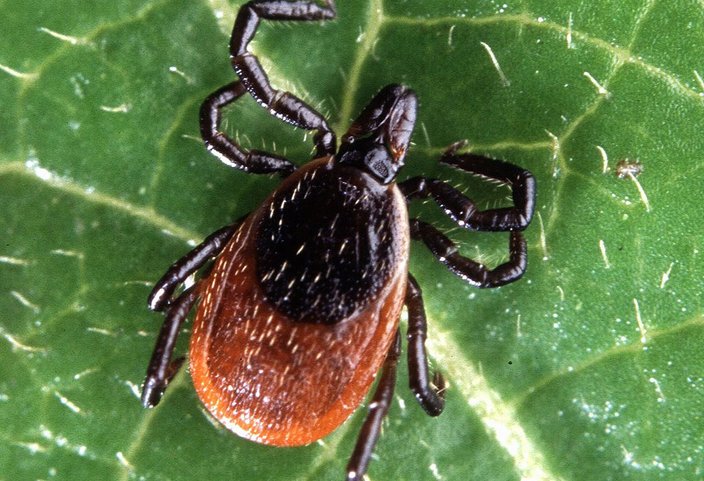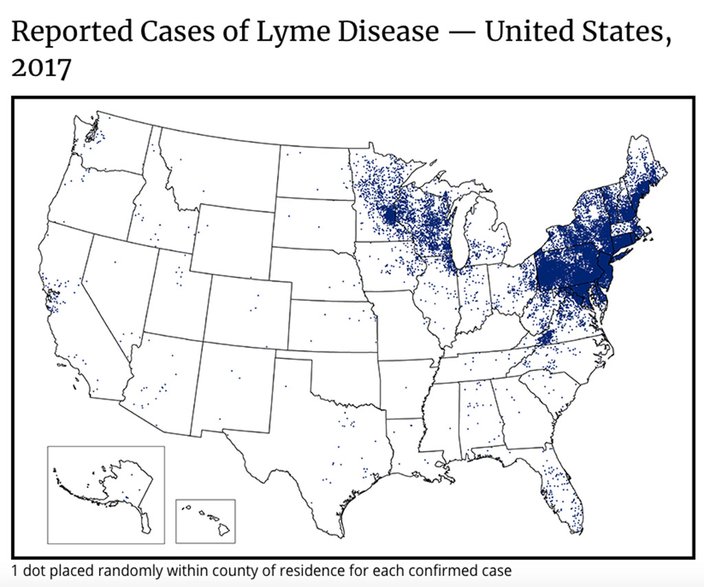
May 14, 2019
 Photo by James Gathany/CDC
Photo by James Gathany/CDC
An expanding rash is an initial sign of about 80 percent of Lyme infections. The rash may look like a "bull's eye," as pictured, in about 80 percent of cases in Europe and 20 percent of cases in the United States.
The U.S. Centers for Disease Control and Prevention estimate that 300,000 Americans are infected with Lyme disease annually and in 2020 the number of people with Lyme disease in America could hit 2 million. Tick-borne diseases in the United States doubled between 2004 and 2016, with Lyme disease accounting for the majority of the cases. Because of our abundance of grassy and wooded areas, plus the increasing population of deer, our region is one of the highest-risk areas in the nation for exposure to the disease.
Lyme disease is caused by the transmission of a specific type of bacteria from the bite of an infected black-legged, or deer, tick. Only a minority of tick bites result in Lyme disease but if you are bit by an infected deer tick, its resulting illness can be very serious.
Preventing tick bites is the best way to protect yourself and your family from Lyme disease. Spring and summer are the peak seasons, so prepare to keep your family safe while you’re enjoying the great outdoors.
As a born and bred outdoorsman, my husband is a huge proponent of DEET. I have long feared that his use of DEET will have toxic consequences for his body and mind. Even though it is approved for use by the Environmental Protection Agency, I have refused to use it on my son. To me, it seems like poison. But according to the Environmental Working Group – which is my go-to resource for safe products – DEET effectively reduces risk from diseases like Lyme with very low toxicity concerns. According to its 2018 Guide to Bug Repellents, EWG asserts that (with proper application) DEET is safer than most people think, saying that its long history of use shows it is highly effective with minimal safety concerns. Even though the EPA puts no restrictions on the concentration of DEET in products, EWG recommends using insect repellents with less than 30 percent concentration of DEET for people of all ages.
An adult deer tick (Ixodes scapularis).
The American Academy of Pediatrics does not advise using any insect repellent on newborns under two months old. When it comes to DEET, it agrees with EWG, saying babies, toddlers and kids should only use products with less than 30 percent DEET concentration. EWG says to protect your children from Lyme disease, you can also use an insect repellent with either picaridin at 20 percent, IR3535 at 20 percent or oil of lemon eucalyptus at 30-40 percent. One of my go-to baby sources recommends using products with 10 percent DEET once a day on children, and cautions not to use a combined sunscreen/insect repellent as sun protection should be applied more often than bug spray.
Like many parents, I am more interested in all-natural options, like essential oils, for myself and my little one. Oil of lemon eucalyptus is approved for insect repellent use by the EPA, but the organization cautions that it should not be used on children under 3. The AAP says that oil of lemon eucalyptus and two percent soybean oil are as effective as 10 percent DEET products but warns that allergic reactions can sometimes occur with any essential oils so monitor your kids closely after application. Since Killian was a baby, I have used Babyganics natural insect repellent made with plant and essential oils but it is designed to fend off mosquitos, not ticks. After all my recent reading and researching about Lyme disease, I am going to start applying 10 percent DEET to my son’s clothing but not his skin. When Killian turns 3, we will try oil of lemon eucalyptus.
Insect repellent should be applied to exposed skin when outdoors. No matter what insect repellent you choose, the AAP says to never spray it directly onto a child’s face; apply it to your hands and then rub into your little one’s cheeks, forehead and chin (be sure to wash your hands well afterwards). Do not apply any type of bug spray to open sores like cuts or to irritated skin. Keep all insect repellent out of your kids’ hands; adults should always handle the application.
One of the easiest ways to fend off bug bites, including ticks, is to wear proper clothing when outdoors. Even when it is hot and humid, dress in long sleeves and long pants. Wear a hat, socks and closed-toe shoes. The AAP says bug sprays including permethrin are the most effective tick repellent but should only be applied to clothing – never directly onto skin. You can treat your clothing with this spray in a well-ventilated area prior to your outdoor adventures. Once you come in for the day, take off your clothes right away, wash them with hot water and throw them in the dryer on high heat. The high temperature will kill any ticks or bugs that may have hitch-hiked in on your outfit. (For a quick fix, just throw your clothes in the dryer for 10 minutes and wash later.)
The map shows reported cases of Lyme disease in the United States in 2017.
The Mid-Atlantic is a hot spot for tick-borne illnesses like Lyme disease, so the best bet when you are venturing outside for some fun is to prepare for prevention. Pretty much every state in the continental United States is considered high tick activity through the middle of May. Throughout the year, the Northeast, New England, the Upper Midwest (Wisconsin and Minnesota) and Northern California are also prime locations for deer tick and Lyme disease exposure. When packing for your summer vacation or day trips, know if your family is heading into a high-risk area.
Growing up, my parents religiously performed tick checks on my sisters and I when we came inside for the day, even if we had only been playing in the backyard. Now with my toddler, I find the easiest way to conduct a full-body check is in his nightly bath (showering within two hours of coming inside reduces your chances of getting Lyme disease). Self- and spouse-checks are also important. The entire body should be examined but there are several spots that ticks tend to favor including armpits, ears, belly buttons, behind knees, head, in body hair, between legs and around your waist. Be sure to check your pets for ticks every day, too, and ask your veterinarian about tick-prevention products for them.
Your chance of contracting Lyme disease is reduced if a tick is removed from your body within 36 hours. Remove the tick using fine-tipped tweezers. Do not use a match, nail polish or petroleum jelly because it could just make the tick burrow deeper in the skin. Pull the tick off so the head is still attached to its body and the entire bug is removed. If you can’t get the whole tick off, you need to see a doctor. Save the tick in a baggie in case your doctor wants to test it. Wash the area well afterwards with warm water and soap. If you or a member of your family has had a tick removed, pay close attention to any resulting symptoms.
If you have contracted Lyme disease through a tick bite, the following symptoms occur between three and 30 days later: fever, chills, headache, fatigue, muscle and joint aches, and swollen lymph nodes. Most infected people develop an Erythema migrans (EM) rash , which can appear on any area of their body. The rash is usually hot to the touch but rarely itchy or painful and may resemble a bullseye. A month or longer after exposure to Lyme disease, symptoms like severe headaches, neck stiffness, additional EM rashes, severe joint pain and swelling, facial palsy, heart palpitations, dizziness, shortness of breath, short-term memory loss, and nerve pain could occur. The symptoms of Lyme disease are the same in adults and children. If you think you or your kids have been bitten by a deer tick or are exhibiting any of these symptoms, contact your healthcare provider right away. Even if you never saw a tick, if you or anyone in your family develop a weird summer fever or rash after being outdoors it could be the first signs of Lyme disease and you should play it safe and call your doctor immediately.
Experts say that treatment of Lyme disease is highly effective, especially if begun early . We are so lucky to have many incredibly health care options in our region, including Children’s Hospital of Philadelphia, which has highly experienced pediatricians and rheumatologists who are experts at diagnosing and treating Lyme disease in kids. Its website is also a great resource for information about Lyme disease treatment and diagnosis.
Most of us know a family who has been tremendously impacted by Lyme disease. Neurological issues and severe mobility impairment are two of the heartbreaking outcomes that I have heard through friends who have a close relative with Lyme disease. Not all cases are severe, but the disease can be debilitating. Take tick and Lyme disease prevention seriously and if you or a member of your family have been bitten by a deer tick or exhibit any of the symptoms associated with Lyme disease, call your doctor right away.
How do you protect your family from tick bites? Have you or a member of your family been diagnosed with Lyme disease? Share with me and other parents in the comments section, below, or tweet me at @thePhillyVoice and @KathleenEGagnon.
 Photo by Scott Bauer/U.S. Agricultural Research Service
Photo by Scott Bauer/U.S. Agricultural Research Service Source/U.S. Centers for Disease Control and Prevention
Source/U.S. Centers for Disease Control and Prevention